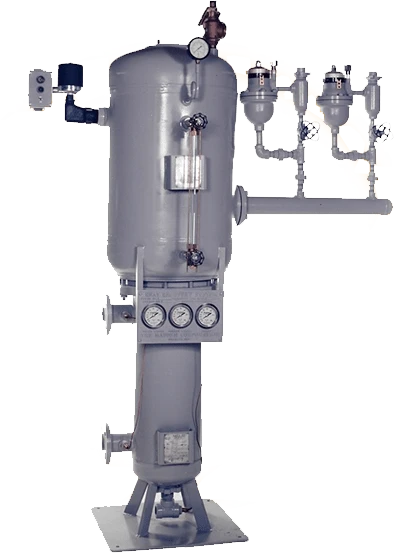What are the Differences Between Intermittent Bottom Blowdown from a Boiler and Continuous Surface Water Blowdown from a Boiler?
July 26, 2019 by Aaron Rhoade
Whether your boiler room has a fire tube type boiler or a water tube type boiler, flushing out dirty water and replacing it with fresh, clean water is a pivotal process in efficient boiling. With larger boilers, often times both top/surface water blowdown is used along with intermittent bottom blowdown. But what is the difference between these processes and why are each of them used? This article will go through each type of boiler blowdown and briefly discuss equipment used to handle each process.
Intermittent bottom boiler blowdown
What is it?
Every boiler, no matter the size or type, is recommended to be blowndown via the bottom blowdown manual valve. As water boils, different types of sediment can form and will settle to the bottom of the boiler. The most common practice is to open up the (usually 1 to 2”) valve wide open and allow the boiler to force out this dirty, impure water to allow for clean water to replace it. This process normally only takes 30 seconds to a minute. Blowing down from the bottom of the boiler is an instantaneous type of process, a hot, noisy burst of pressurized water leaving the boiler. And this calls for a heavy duty tank to handle such a burst of hot, pressurized water.
What purpose does it serve?
The main purpose of bottom boiler blowdown is simply replacing dirty water with clean water; more specifically, blowing out the mud and sediment that accumulates at the bottom of the boiler. Clean water boils more efficiently. Dirty water takes up valuable capacity within your boiler, causing you to burn more fuel than you would otherwise have to, to produce the amount of steam your application calls for.
What equipment handles it?
When Madden Manufacturing designs boiler blowoff tanks for this process, we follow the National Board of Boiler and Pressure Vessels Inspectors’ guideline of a 4” level drop; meaning, any boiler blowdown tank or boiler blowdown separator should be designed to handle up to a 4” level drop from your boiler’s drum. The next factor would be sizing the vent. When this hot, pressurized water enters an atmospheric tank, a certain percentage of it will immediately flash to steam. The vent must be large enough to allow the steam to exit without allowing pressure to build within the tank, and ideally it is large enough to reduce the noise and velocity through it at an acceptable level. Finally, the drain, which must be large enough for the remaining condensate to be draining at less than 7 fps. You can read more on this boiler blowdown equipment here.
Continuous surface boiler blowdown
What is it?
Unlike the bottom blowdown process, a boiler’s surface water is only recommended on larger boilers. For a rule of thumb, think boilers around 250 HP or larger. Surface water blowdown is a slow, continuous skimming off of the top level of the boiler water. This is often done via a 1” line found midway up the boiler, via an automated system or manual orifice meter. The automated systems are called TDS systems, Total Dissolved Solids, and they often are measuring the conductivity in your boiler water and blowing down a specified amount of surface water at a continuous rate based on the conductivity level.
What purpose does it serve?
Like intermittent bottom blowdown, surface blowdown is used to allow disposal of dirty water, replaced by fresh water. More specifically though, on large enough boilers, dissolved solids and impurities can be suspended in the water as well as float to the top. This can cause scale to form around the fire or water tubes in your boiler, effectively insulating the heat from your fuel source from directly transferring into the water. Thus reducing boiler efficiency. Hour after hour your boiler will be calling for more fuel than it would if a minor, yet constant blowdown of the surface water was being performed.

What Equipment Handles It?
For some, the boiler blowdown tank is called on to also handle the continuous surface blowdown as it is relatively such a small amount. This requires constant tempering/cooling water to quench with the blowdown, which is costly and wasteful.
In most cases, this is NOT the best way to handle the top, surface water blowdown. For continuous blowdown applications, a heat recovery system is best. Heat recovery systems not only handle the hot, high pressure blowdown by allowing it to flash steam and then cooling the remaining condensate, but they also return heat into the boiler, which would have otherwise been wasted.
You can learn more about boiler heat recovery systems here. The basic principal is a flash tank allows steam to be vented and then piped back into the D/A tank, and then the remaining condensate passes through a heat exchanger which is cooled by the boiler’s makeup water. Steam contains a significant amount of BTU’s (amount of energy needed to increase temperature of water by 1 degree), this along with the BTU’s picked up in the boiler feed water from passing through the heat exchanger is what allows heat recovery systems to reduce your boiler’s fuel consumption, thus paying themselves off in a short amount of time. Usually 4-6 months.
So not only are you reducing fuel consumption by keeping your boiler water clean and heating tubes free from scale, you will be directly adding heat back into the boiler with this equipment.
Conclusion
Whether it is intermittent or continuous, replacing dirty water in your boiler is a vital, yet often underappreciated, part of the boiling operation. Blowing down boiler water increases equipment service life and reduces fuel consumption.
For more information on equipment for these processes, please reach out to a local distributor or directly to our factory. We’d be happy to help start making your boiler room safer and more energy efficient.
